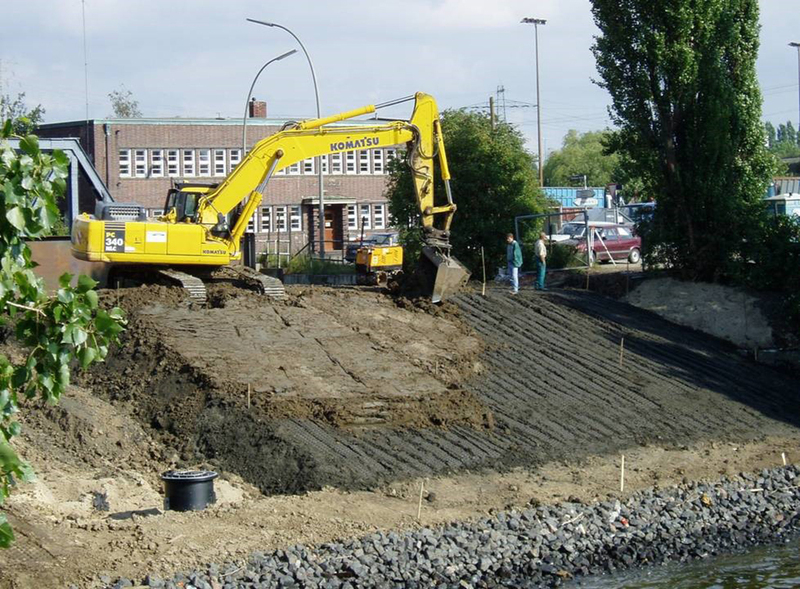Use in dyke construction reinforcement
Following the positive assessment of METHA material (see: R1A_1993_D-MethaHamburg) as secondary raw material for landfill surface sealing systems, the Hamburg Port Authority (HPA) investigated its suitability as dike construction material. The objectives were to:
- further the consequent beneficial use of mineral waste materials;
- spare natural resources (clay-rich natural marsh soils);
- enhance cost-effectiveness of depth maintenance in the port of Hamburg.
The design envisages replacement of the lower part of the dike cover with METHA material, while for the top layer the traditional, natural clayey, material from the tidal marsh area in Northwestern Germany continues to be employed. Investigations are carried out in two phases: (1) Geotechnical suitability and (2) environmental suitability. The latter focuses on the potential mobilization and release of contaminants. Both aspects were investigated by research projects for which the Hamburg University if Technology and the University of Hamburg were contracted and thereafter assessed by a third independent expert opinion. The assessment is based on laboratory and field investigations. The latter comprise two long-term field pilot dikes which are in operation since 2004 (Ellerholzkanalbrücken) and 2006 (Drewer Hauptdeich).
Results indicate that from a geotechnical point of view the material is suitable for dike construction. In 13 years of operation a field pilot at Ellerholzkanalbrücken, regularly exposed to storm water tides, never gave reasons for concern of failure. Laboratory experiments on compression show that enhanced drying prior to construction minimizes in situ crack formation. The release of contaminants to the groundwater or surface waters is judged irrelevant based on comparison with the current environmental legislation. Leachate analyses indicate that the inorganic as well as the organic contaminant inventory is firmly occluded in stable mineral and organic compounds. Following the experts’ assessment, HPA has started in 2017 the process of approval by the Hamburg Ministry for Environmental Protection and Energy (BUE) to use METHA material as an alternative design variant in the process for current dike strengthening projects.
Graphical information:

References/web links
- Gebert, J., Timmers, V., Gröngröft, A., Grabe, J. (2014). Verwertung von behandeltem Baggergut als Ersatzbaustoff im Deichbau. Proceedings annual HTG congress 2014, Berlin.
- Gröngröft, A., Gebert, J., and Eschenbach, A. (2014). Water balance of dikes constructed with dredged material – results from a long-term field test. Proceedings of the South Baltic Conference on Dredged Materials in Dike Construction, pp. 61-66. Rostock, 10-12 April 2014, ISBN: 978-3-86009-409-9.
- Saathoff, F., Cantré, S., Sikora, Z. (eds.) (2013). South Baltic Guideline for the Application of Dredged Materials, Coal Combustion Products and Geosynthetics in Dike Construction. http://www.dredgdikes.eu/wp-content/uploads/DredgDikes_guideline_EN_online.pdf